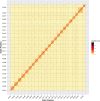Chromosome-level genome assembly of largemouth bass (Micropterus salmoides) using PacBio and Hi-C technologies
- PMID: 35933561
- PMCID: PMC9357066
- DOI: 10.1038/s41597-022-01601-1
Chromosome-level genome assembly of largemouth bass (Micropterus salmoides) using PacBio and Hi-C technologies
Abstract
The largemouth bass (Micropterus salmoides) has become a cosmopolitan species due to its widespread introduction as game or domesticated fish. Here a high-quality chromosome-level reference genome of M. salmoides was produced by combining Illumina paired-end sequencing, PacBio single molecule sequencing technique (SMRT) and High-through chromosome conformation capture (Hi-C) technologies. Ultimately, the genome was assembled into 844.88 Mb with a contig N50 of 15.68 Mb and scaffold N50 length of 35.77 Mb. About 99.9% assembly genome sequences (844.00 Mb) could be anchored to 23 chromosomes, and 98.03% assembly genome sequences could be ordered and directed. The genome contained 38.19% repeat sequences and 2693 noncoding RNAs. A total of 26,370 protein-coding genes from 3415 gene families were predicted, of which 97.69% were functionally annotated. The high-quality genome assembly will be a fundamental resource to study and understand how M. salmoides adapt to novel and changing environments around the world, and also be expected to contribute to the genetic breeding and other research.
© 2022. The Author(s).
Conflict of interest statement
The authors declare no competing interests.
Figures



Similar articles
-
Draft genome assembly of the largemouth bass (Micropterus salmoides).BMC Genom Data. 2025 Apr 16;26(1):28. doi: 10.1186/s12863-025-01318-1. BMC Genom Data. 2025. PMID: 40234748 Free PMC article.
-
Chromosome-level genome assembly for the largemouth bass Micropterus salmoides provides insights into adaptation to fresh and brackish water.Mol Ecol Resour. 2021 Jan;21(1):301-315. doi: 10.1111/1755-0998.13256. Epub 2020 Oct 20. Mol Ecol Resour. 2021. PMID: 32985096
-
Chromosome-level genome assembly and annotation of the yellow grouper, Epinephelus awoara.Sci Data. 2024 Jan 31;11(1):151. doi: 10.1038/s41597-024-02989-8. Sci Data. 2024. PMID: 38296995 Free PMC article.
-
De novo assembly of a chromosome-level reference genome of red-spotted grouper (Epinephelus akaara) using nanopore sequencing and Hi-C.Mol Ecol Resour. 2019 Nov;19(6):1461-1469. doi: 10.1111/1755-0998.13064. Epub 2019 Aug 14. Mol Ecol Resour. 2019. PMID: 31325912 Free PMC article.
-
Chromosome-Level Assembly of the Southern Rock Bream (Oplegnathus fasciatus) Genome Using PacBio and Hi-C Technologies.Front Genet. 2021 Dec 21;12:811798. doi: 10.3389/fgene.2021.811798. eCollection 2021. Front Genet. 2021. PMID: 34992639 Free PMC article. Review.
Cited by
-
Fishing for Florida Bass in West Virginia: Genomic Evaluation of Florida Bass Presence and Establishing Baselines of Genetic Structure and Diversity for Native Largemouth Bass.Biology (Basel). 2025 Apr 9;14(4):392. doi: 10.3390/biology14040392. Biology (Basel). 2025. PMID: 40282257 Free PMC article.
-
Genome-Wide Association Study Reveals Growth-Related SNPs and Candidate Genes in Largemouth Bass (Micropterus salmoides) Adapted to Hypertonic Environments.Int J Mol Sci. 2025 Feb 20;26(5):1834. doi: 10.3390/ijms26051834. Int J Mol Sci. 2025. PMID: 40076461 Free PMC article.
-
Comparative Transcriptomic Analysis of Largemouth Bass (Micropterus salmoides) Livers Reveals Response Mechanisms to High Temperatures.Genes (Basel). 2023 Nov 17;14(11):2096. doi: 10.3390/genes14112096. Genes (Basel). 2023. PMID: 38003039 Free PMC article.
-
Chromosome-level assembly of Dictyophora rubrovolvata genome using third-generation DNA sequencing and Hi-C analysis.G3 (Bethesda). 2023 Aug 9;13(8):jkad102. doi: 10.1093/g3journal/jkad102. G3 (Bethesda). 2023. PMID: 37178144 Free PMC article.
-
Whole genome resequencing reveals the correlation between selection signatures and adaptability of Micropterus salmoides to artificial fed.Sci Rep. 2024 Dec 3;14(1):30058. doi: 10.1038/s41598-024-80904-2. Sci Rep. 2024. PMID: 39627258 Free PMC article.
References
-
- Bai J, Dijar L-C, Quan Y, Liang S. Taxonomic status and genetic diversity of cultured largemouth bass Micropterus salmoides in China. Aquaculture. 2008;278:27–30. doi: 10.1016/j.aquaculture.2008.03.016. - DOI
-
- García-Berthou E, et al. Introduction pathways and establishment rates of invasive aquatic species in Europe. Can. J. Fish. Aquat. Sci. 2005;62:453–463. doi: 10.1139/f05-017. - DOI
-
- García-Berthou, E. Ontogenetic diet shifts and interrupted piscivoryin introduced largemouth bass (Micropterus salmoides). Int. Rev. Hydrobiol. 87, 353–363, 10.1002/1522-2632(200207)87:4%3C353::AID-IROH353%3E3.0.CO;2-N (2002).
Publication types
MeSH terms
Grants and funding
LinkOut - more resources
Full Text Sources
Miscellaneous

